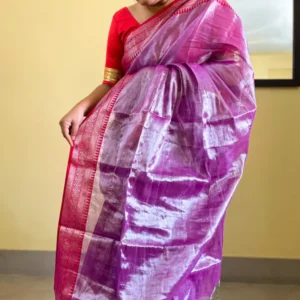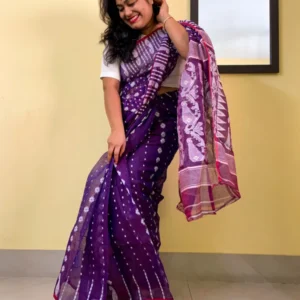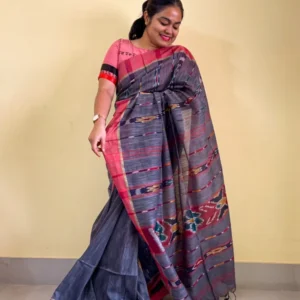The Anwa Saree is a lesser-known but highly treasured handloom product originating from the Anwa village in Tonk district, Rajasthan. This saree is woven entirely by hand, using techniques passed down through generations of weavers. Each Anwa Saree is a work of art, characterized by its intricate geometric Zari-Buti designs and the distinctive striped aanchal, or pallu. The saree is typically made from 100% cotton yarns that undergo mercerization, a process that gives the fabric increased strength, durability, and a lustrous finish. What makes the Anwa Saree truly special is the meticulous craftsmanship involved in its creation, reflecting the rich cultural heritage of Rajasthan.
Historical Background
Origin in Anwa, Rajasthan
The Anwa Saree finds its origin in the small village of Anwa in the Tonk district of Rajasthan, a region renowned for its handloom weaving tradition. The history of Anwa Saree weaving dates back several centuries, during which time the craft has been nurtured by generations of skilled weavers. The region’s access to high-quality cotton and a long-standing tradition of textile art provided a fertile ground for the development of this saree. Historically, these sarees were primarily woven for local use, especially for important festivals and family ceremonies. The weavers of Anwa were known for their ability to create intricate patterns using the most basic of tools, relying heavily on their knowledge of traditional weaving techniques.
Evolution Over Time
The design and motifs of Anwa Sarees have evolved over time, influenced by changing cultural dynamics and market trends. While the fundamental techniques have remained consistent, the introduction of Zari (metallic thread) work in the 19th century marked a significant evolution in the design of these sarees. Initially, the sarees were woven in a limited color palette, predominantly using natural dyes derived from plants, minerals, and insects. However, with the advent of synthetic dyes in the early 20th century, a broader spectrum of colors became available, allowing for more vibrant and diverse designs. Despite these changes, the essence of the Anwa Saree—its intricate patterns and elegant simplicity—has remained intact.
Craftsmanship and Techniques
Weaving Process
The process of weaving an Anwa Saree is labor-intensive and time-consuming, often taking several days to complete a single saree. The saree is woven on a traditional handloom using a combination of warp (the lengthwise threads) and weft (the crosswise threads). The intricate patterns are created using the Dobby mechanism, which allows for precise control over the warp threads to form detailed geometric motifs. The Zari-Buti designs, which are a hallmark of the Anwa Saree, are woven using extra weft threads that are interlaced with the base fabric to create raised patterns. These designs often feature motifs such as peacocks, flowers, and geometric shapes, each symbolizing different aspects of Rajasthani culture. The weaving process requires not only technical skill but also a deep understanding of the interplay between colors and patterns.
Material and Fabric
The Anwa Saree is made from 100% cotton yarns, which are known for their softness, breathability, and comfort. The cotton used in these sarees is often sourced locally, supporting the agricultural economy of the region. Once the yarns are spun, they undergo mercerization, a treatment process that involves soaking the yarns in a solution of sodium hydroxide. This process increases the yarn’s tensile strength, enhances its dye uptake, and imparts a silky sheen to the fabric. Mercerization also makes the cotton more resistant to mildew and shrinkage, ensuring the saree’s durability. The use of high-quality cotton and the meticulous attention to detail in the weaving process result in a fabric that is both luxurious and long-lasting.
Design and Aesthetics
The design of the Anwa Saree is characterized by its geometric Zari-Buti patterns and a beautifully woven striped aanchal. The Zari-Buti designs are created using extra weft threads, which are skillfully interlaced with the base fabric to form intricate motifs. These motifs often feature traditional Rajasthani symbols, such as the peacock, which is the national bird of India and a common element in Rajasthani art. The striped aanchal is another distinctive feature of the Anwa Saree, with stripes varying in width and color to create a visually striking contrast with the body of the saree. The color palette of the Anwa Saree is diverse, ranging from soft pastels to bold, vibrant hues, making it suitable for both formal and casual occasions. The combination of traditional and modern designs ensures that the Anwa Saree remains relevant in today’s fashion landscape.
Cultural Significance
Role in Traditional Ceremonies
The Anwa Saree holds a special place in the cultural fabric of Rajasthan, where it is often worn during important ceremonies and festivals. During weddings, for instance, the saree is worn by brides and close relatives as a symbol of purity, elegance, and cultural pride. The intricate Zari-Buti patterns are believed to bring good fortune and prosperity, making the Anwa Saree a popular choice for bridal wear. In addition to weddings, the saree is also worn during major festivals such as Diwali, Holi, and Teej, where traditional attire is an integral part of the celebrations. The saree’s association with these cultural events underscores its importance as a symbol of Rajasthani heritage.
Representation of Rajasthani Heritage
The Anwa Saree is more than just a piece of clothing; it is a representation of the rich cultural heritage of Rajasthan. The motifs and patterns used in the saree often carry symbolic meanings that reflect the traditions, beliefs, and values of the region. For example, the peacock motif, which is commonly featured in Anwa Sarees, is a symbol of beauty, grace, and fertility in Rajasthani culture. Similarly, the use of geometric patterns in the saree’s design can be traced back to ancient Rajasthani architecture and art, which often feature similar motifs. The Anwa Saree is also a testament to the resilience and creativity of the weavers, who continue to preserve and innovate upon this traditional craft despite the challenges they face.
Modern-Day Relevance
Current Trends
In recent years, the Anwa Saree has seen a resurgence in popularity, driven by a growing appreciation for handloom products and a renewed interest in traditional Indian attire. The saree has become a favorite among fashion designers, celebrities, and influencers, who have played a significant role in bringing it back into the spotlight. The trend of sustainable and ethical fashion has also contributed to the saree’s resurgence, as more consumers seek out products that are handmade and environmentally friendly. The Anwa Saree, with its rich history, intricate craftsmanship, and timeless appeal, fits perfectly into this trend, making it a sought-after item in the fashion world.
Market and Economic Impact
The production and sale of Anwa Sarees play a crucial role in the local economy of Anwa and the surrounding regions. Each saree typically sells for between ₹3500 and ₹5500, depending on the complexity of the design and the quality of the materials used. This price range makes the saree accessible to a wide audience while ensuring that the weavers are fairly compensated for their work. The handloom sector is a significant source of employment in Rajasthan, providing livelihoods for thousands of artisans and their families. By purchasing Anwa Sarees, consumers not only acquire a beautiful and unique garment but also support the preservation of a traditional craft and the economic well-being of the weavers who create them.
Challenges and Opportunities
Preservation of Traditional Craft
Despite its cultural and economic significance, the Anwa Saree faces several challenges that threaten its survival. One of the most pressing issues is the decline in the weaver population, as younger generations are increasingly moving away from traditional crafts in search of more lucrative opportunities in urban areas. The lack of formal education and training in traditional weaving techniques further exacerbates this issue, as fewer young people are willing to take up the craft. Additionally, the rise of mechanized textile production poses a significant threat to handmade sarees, which are often more time-consuming and labor-intensive to produce. The influx of cheap, mass-produced textiles has led to a decline in demand for handloom products, making it difficult for weavers to sustain their livelihoods.
Revival Initiatives
To address these challenges, various initiatives have been launched by the government, non-governmental organizations (NGOs), and private enterprises to promote and preserve traditional weaving practices. For example, the Ministry of Textiles in India has implemented several schemes aimed at supporting handloom weavers, such as the Handloom Mark Scheme, which certifies the authenticity of handloom products and helps build consumer trust. NGOs and social enterprises have also played a crucial role in providing training and education to young weavers, as well as creating platforms for the promotion and sale of handloom products. The growing demand for handmade and sustainable products in the global market presents a significant opportunity for the revival of the Anwa Saree, as consumers become more conscious of the environmental and social impact of their purchases.

 Violet Raaga Tissue Saree with Contrast Border
Violet Raaga Tissue Saree with Contrast Border  Green Soft Cotton Saree with Parijat Motifs
Green Soft Cotton Saree with Parijat Motifs  Purple Soft Jamdani Saree with Floral Motifs
Purple Soft Jamdani Saree with Floral Motifs  Blue Semi Modal Silk Saree with Ajrakh Polka Dots
Blue Semi Modal Silk Saree with Ajrakh Polka Dots  Grey Sambalpuri Ikat Printed Soft Cotton Saree
Grey Sambalpuri Ikat Printed Soft Cotton Saree 